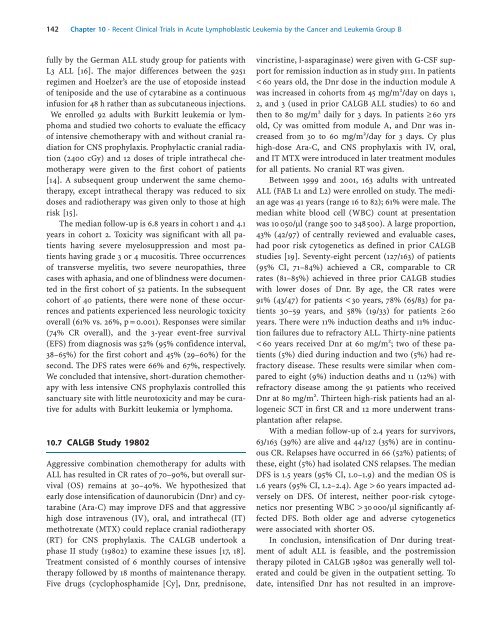Acute Leukemias - Republican Scientific Medical Library
Acute Leukemias - Republican Scientific Medical Library
Acute Leukemias - Republican Scientific Medical Library
Create successful ePaper yourself
Turn your PDF publications into a flip-book with our unique Google optimized e-Paper software.
142 Chapter 10 · Recent Clinical Trials in <strong>Acute</strong> Lymphoblastic Leukemia by the Cancer and Leukemia Group B<br />
fully by the German ALL study group for patients with<br />
L3 ALL [16]. The major differences between the 9251<br />
regimen and Hoelzer’s are the use of etoposide instead<br />
of teniposide and the use of cytarabine as a continuous<br />
infusion for 48 h rather than as subcutaneous injections.<br />
We enrolled 92 adults with Burkitt leukemia or lymphoma<br />
and studied two cohorts to evaluate the efficacy<br />
of intensive chemotherapy with and without cranial radiation<br />
for CNS prophylaxis. Prophylactic cranial radiation<br />
(2400 cGy) and 12 doses of triple intrathecal chemotherapy<br />
were given to the first cohort of patients<br />
[14]. A subsequent group underwent the same chemotherapy,<br />
except intrathecal therapy was reduced to six<br />
doses and radiotherapy was given only to those at high<br />
risk [15].<br />
The median follow-up is 6.8 years in cohort 1 and 4.1<br />
years in cohort 2. Toxicity was significant with all patients<br />
having severe myelosuppression and most patients<br />
having grade 3 or 4 mucositis. Three occurrences<br />
of transverse myelitis, two severe neuropathies, three<br />
cases with aphasia, and one of blindness were documented<br />
in the first cohort of 52 patients. In the subsequent<br />
cohort of 40 patients, there were none of these occurrences<br />
and patients experienced less neurologic toxicity<br />
overall (61% vs. 26%, p=0.001). Responses were similar<br />
(74% CR overall), and the 3-year event-free survival<br />
(EFS) from diagnosis was 52% (95% confidence interval,<br />
38–65%) for the first cohort and 45% (29–60%) for the<br />
second. The DFS rates were 66% and 67%, respectively.<br />
We concluded that intensive, short-duration chemotherapy<br />
with less intensive CNS prophylaxis controlled this<br />
sanctuary site with little neurotoxicity and may be curative<br />
for adults with Burkitt leukemia or lymphoma.<br />
10.7 CALGB Study 19802<br />
Aggressive combination chemotherapy for adults with<br />
ALL has resulted in CR rates of 70–90%, but overall survival<br />
(OS) remains at 30–40%. We hypothesized that<br />
early dose intensification of daunorubicin (Dnr) and cytarabine<br />
(Ara-C) may improve DFS and that aggressive<br />
high dose intravenous (IV), oral, and intrathecal (IT)<br />
methotrexate (MTX) could replace cranial radiotherapy<br />
(RT) for CNS prophylaxis. The CALGB undertook a<br />
phase II study (19802) to examine these issues [17, 18].<br />
Treatment consisted of 6 monthly courses of intensive<br />
therapy followed by 18 months of maintenance therapy.<br />
Five drugs (cyclophosphamide [Cy], Dnr, prednisone,<br />
vincristine, l-asparaginase) were given with G-CSF support<br />
for remission induction as in study 9111. In patients<br />
< 60 years old, the Dnr dose in the induction module A<br />
was increased in cohorts from 45 mg/m 2 /day on days 1,<br />
2, and 3 (used in prior CALGB ALL studies) to 60 and<br />
then to 80 mg/m 2 daily for 3 days. In patients ³60 yrs<br />
old, Cy was omitted from module A, and Dnr was increased<br />
from 30 to 60 mg/m 2 /day for 3 days. Cy plus<br />
high-dose Ara-C, and CNS prophylaxis with IV, oral,<br />
and IT MTX were introduced in later treatment modules<br />
for all patients. No cranial RT was given.<br />
Between 1999 and 2001, 163 adults with untreated<br />
ALL (FAB L1 and L2) were enrolled on study. The median<br />
age was 41 years (range 16 to 82); 61% were male. The<br />
median white blood cell (WBC) count at presentation<br />
was 10 050/ll (range 500 to 348500). A large proportion,<br />
43% (42/97) of centrally reviewed and evaluable cases,<br />
had poor risk cytogenetics as defined in prior CALGB<br />
studies [19]. Seventy-eight percent (127/163) of patients<br />
(95% CI, 71–84%) achieved a CR, comparable to CR<br />
rates (81–85%) achieved in three prior CALGB studies<br />
with lower doses of Dnr. By age, the CR rates were<br />
91% (43/47) for patients < 30 years, 78% (65/83) for patients<br />
30–59 years, and 58% (19/33) for patients ³60<br />
years. There were 11% induction deaths and 11% induction<br />
failures due to refractory ALL. Thirty-nine patients<br />
< 60 years received Dnr at 60 mg/m 2 ; two of these patients<br />
(5%) died during induction and two (5%) had refractory<br />
disease. These results were similar when compared<br />
to eight (9%) induction deaths and 11 (12%) with<br />
refractory disease among the 91 patients who received<br />
Dnr at 80 mg/m 2 . Thirteen high-risk patients had an allogeneic<br />
SCT in first CR and 12 more underwent transplantation<br />
after relapse.<br />
With a median follow-up of 2.4 years for survivors,<br />
63/163 (39%) are alive and 44/127 (35%) are in continuous<br />
CR. Relapses have occurred in 66 (52%) patients; of<br />
these, eight (5%) had isolated CNS relapses. The median<br />
DFS is 1.5 years (95% CI, 1.0–1.9) and the median OS is<br />
1.6 years (95% CI, 1.2–2.4). Age > 60 years impacted adversely<br />
on DFS. Of interest, neither poor-risk cytogenetics<br />
nor presenting WBC > 30000/ll significantly affected<br />
DFS. Both older age and adverse cytogenetics<br />
were associated with shorter OS.<br />
In conclusion, intensification of Dnr during treatment<br />
of adult ALL is feasible, and the postremission<br />
therapy piloted in CALGB 19802 was generally well tolerated<br />
and could be given in the outpatient setting. To<br />
date, intensified Dnr has not resulted in an improve-
















